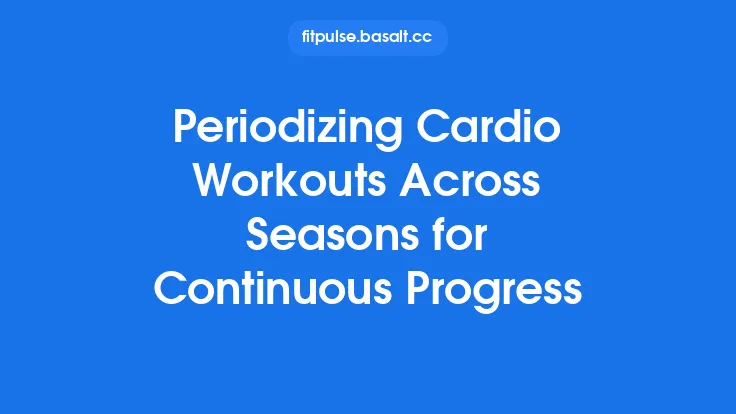Low‑intensity steady‑state (LISS) cardio is often perceived as a “set‑and‑forget” form of training, but even at modest intensities the body continues to adapt when the stimulus is systematically increased. The principle of progressive overload—gradually raising the demands placed on the cardiovascular and muscular systems—applies just as strongly to LISS as it does to high‑intensity or resistance work. By thoughtfully adjusting the variables that define a LISS session, athletes can keep the training stimulus fresh, avoid plateaus, and continue to reap improvements in aerobic efficiency, metabolic flexibility, and overall conditioning.
Understanding Progressive Overload in a Low‑Intensity Context
Progressive overload is not synonymous with “harder” in the sense of pushing into high‑intensity zones. Instead, it means incrementally expanding the total work performed while remaining within the low‑intensity band (typically 50‑65 % of VO₂max or the corresponding heart‑rate range). The body responds to any sustained increase in workload by:
- Enhancing mitochondrial density and oxidative enzyme activity – even modest increases in volume stimulate the biogenesis of mitochondria, improving the muscles’ ability to oxidize fat and glucose.
- Improving capillary perfusion – longer or more frequent sessions encourage angiogenesis, delivering oxygen and nutrients more efficiently.
- Refining cardiac stroke volume – the heart adapts to handle a larger volume of blood per beat, which is especially relevant when session duration is extended.
Because the intensity remains low, the stress placed on joints, connective tissue, and the nervous system is minimal, allowing for relatively high frequencies and volumes without excessive fatigue. The challenge lies in identifying which training variables can be tweaked without inadvertently crossing the threshold into moderate‑intensity territory.
Key Variables to Manipulate
| Variable | How It Influences Load | Typical Low‑Intensity Limits |
|---|---|---|
| Duration | Directly increases total work (time × speed × resistance). | Often capped at 60–90 min per session to stay within low‑intensity heart‑rate zones. |
| Frequency | More sessions per week raise weekly volume. | 4–6 sessions weekly are common; careful monitoring prevents cumulative fatigue. |
| Distance/Volume | Total meters or miles covered; a function of duration and speed. | Same as duration limits; can be expressed as weekly mileage. |
| Gradient/Resistance | Adds mechanical load while preserving metabolic intensity. | Small increments (e.g., 0.5–1 % incline or 5–10 W resistance) keep HR in target zone. |
| Cadence/Pace | Slightly faster cadence raises external work without large HR spikes. | 5–10 % increase in cadence is usually safe. |
| Environmental Factors | Temperature, wind, and altitude affect perceived effort. | Adjustments should be modest to avoid excessive cardiovascular strain. |
| Session Structure | Adding brief “micro‑bursts” (e.g., 30 s at a slightly higher pace) can increase total work while staying low‑intensity overall. | Bursts should stay below lactate threshold; total burst time <10 % of session. |
By systematically progressing one or two of these variables at a time, you maintain a clear cause‑and‑effect relationship between the training change and the physiological response.
Duration‑Based Progression
Why Duration?
Increasing the time spent in the low‑intensity zone is the most straightforward way to add load. Because metabolic demand rises linearly with time at a constant intensity, a 10‑minute extension translates directly into 10 % more work.
Practical Steps
- Baseline Establishment – Record the average duration of your current LISS sessions over a 2‑week window.
- Incremental Add‑On – Add 5 % to the baseline duration each week (e.g., from 40 min to 42 min, then 44 min).
- Micro‑Step Check – After three consecutive weeks of increase, pause for a “recovery week” where you revert to the original duration to allow super‑compensation.
- Upper Limit – Once you reach 90 min per session, consider shifting focus to other variables (gradient, frequency) to avoid diminishing returns.
Monitoring
Use a simple log to track total minutes per session and cumulative weekly minutes. A gradual upward trend without spikes in perceived fatigue indicates successful overload.
Frequency and Session Distribution
Why Frequency?
When duration is already near the practical ceiling, adding more sessions per week raises the weekly training volume while keeping each individual session comfortably low‑intensity.
Implementation Blueprint
| Week | Sessions per Week | Example Schedule |
|---|---|---|
| 1–2 | 4 | Mon, Wed, Fri, Sun |
| 3–4 | 5 | Mon, Tue, Thu, Fri, Sun |
| 5–6 | 6 | Mon–Sat (rest on Sun) |
| 7+ | 5–6 (maintenance) | Adjust based on recovery |
Guidelines
- Spacing – Ensure at least 24 h between sessions to allow cardiac and muscular recovery.
- Recovery Days – Use active recovery (light walking, gentle mobility) on off days; avoid high‑intensity work that could interfere with the low‑intensity adaptations.
- Periodization – Cycle through “high‑frequency” blocks (5–6 sessions) followed by “recovery weeks” (4 sessions) to prevent chronic fatigue.
Incremental Resistance and Gradient Adjustments
Even at low heart‑rate zones, adding a modest amount of external resistance forces the muscles to work harder, stimulating cardiovascular adaptations without raising metabolic intensity dramatically.
Approach
- Identify Baseline Resistance – On a treadmill, this might be a 0 % incline; on a bike, a 0 W or low gear setting.
- Step Increase – Raise the incline by 0.5 % or the resistance by 5 W every 2–3 weeks.
- Validate Intensity – Confirm that heart‑rate remains within the target low‑intensity range after the change. If it spikes, reduce the increment.
- Combine with Duration – When you reach a plateau in duration, pair a small resistance increase with a modest time extension (e.g., +5 min + 0.5 % incline).
Why It Works
The added mechanical load recruits more type I muscle fibers, enhancing capillary density and mitochondrial content specific to those fibers, which translates into better endurance at low intensities.
Cadence and Pace Modulation
Speed is a double‑edged sword: raising it increases external work but can also push heart‑rate into higher zones. However, small, controlled cadence adjustments can be used safely.
Methodology
- Baseline Cadence – Determine the average steps per minute (walking) or revolutions per minute (cycling) that keeps you in the low‑intensity heart‑rate band.
- Incremental Change – Increase cadence by 5 % for a single session, then assess heart‑rate response.
- Progressive Ladder – Over a 4‑week cycle, apply the higher cadence for 2–3 sessions per week, then revert to baseline for the remaining sessions.
- Micro‑Bursts – Insert 30‑second “tempo” intervals at the higher cadence, followed by a return to baseline. Keep total burst time under 10 % of the session.
Physiological Rationale
A slightly faster cadence improves neuromuscular coordination and raises the demand on the cardiovascular system in a controlled manner, encouraging modest improvements in stroke volume and oxygen delivery without crossing the lactate threshold.
Environmental and Terrain Variables
Changing the external environment can subtly increase workload while preserving low metabolic intensity.
Options
- Surface Variation – Move from a smooth indoor floor to a grass or sand surface; the latter requires more muscular effort for stabilization.
- Temperature – Exercising in mildly cooler (10–15 °C) or warmer (20–25 °C) conditions can affect thermoregulatory load, slightly raising cardiovascular demand.
- Altitude – Training at modest elevations (1,000–1,500 m) reduces oxygen availability, prompting the body to adapt without a change in speed or resistance.
Implementation Tips
- Introduce one environmental change at a time and monitor heart‑rate to ensure you remain within the low‑intensity window.
- Use these variables primarily during “overload weeks” to add novelty and prevent monotony.
Periodization Models for LISS
Applying classic periodization concepts to LISS helps structure overload and recovery phases systematically.
1. Linear Periodization
- Weeks 1–4: Baseline volume (e.g., 4 × 45 min).
- Weeks 5–8: Incremental increase in duration (+5 % per week).
- Weeks 9–12: Add resistance/gradient (+0.5 % incline).
- Weeks 13–14: Deload (reduce volume by 20 %).
2. Undulating (Non‑Linear) Periodization
- Week A: High frequency, moderate duration (5 sessions × 40 min).
- Week B: Low frequency, long duration (4 sessions × 60 min).
- Week C: Moderate frequency, added resistance (5 sessions × 45 min + 0.5 % incline).
3. Block Periodization
- Block 1 (3 weeks): Focus on duration.
- Block 2 (3 weeks): Focus on gradient/resistance.
- Block 3 (3 weeks): Focus on cadence/pace.
- Recovery Week: Return to baseline values across all variables.
Choosing a Model
Athletes with stable schedules often benefit from linear progression, while those seeking variety or who have fluctuating training loads may prefer undulating or block approaches.
Tracking and Data‑Driven Adjustments
Objective data is essential for confirming that overload is occurring without unintended intensity spikes.
Metrics to Record
- Session Time – Total minutes per workout.
- Distance/Volume – Kilometers or miles covered.
- Average Pace/Cadence – Steps/min or revolutions/min.
- Resistance/Gradient – Numeric setting (incline %, wattage, gear).
- Heart‑Rate Zone Confirmation – Percentage of time spent in the low‑intensity band (optional but useful for validation).
Analysis Workflow
- Weekly Summary – Aggregate total minutes, distance, and average resistance.
- Trend Line – Plot weekly volume to visualize progressive increase.
- Plateau Detection – If the trend flattens for two consecutive weeks, introduce a new variable (e.g., add 0.5 % incline).
- Recovery Check – Ensure that any week with a >10 % jump in volume is followed by a deload or maintenance week.
Technology Options
Smart watches, bike computers, or dedicated cardio apps can automatically capture most of these data points. Export the CSV file to a spreadsheet for custom trend analysis.
Common Pitfalls and How to Avoid Them
| Pitfall | Why It Happens | Prevention Strategy |
|---|---|---|
| Unintended Intensity Spike | Adding too much resistance or pace too quickly. | Increase variables in ≤10 % increments and verify heart‑rate stays in target zone. |
| Monotony Leading to Dropout | Repeating identical sessions for weeks. | Rotate variables (duration one week, gradient the next) and incorporate environmental changes. |
| Excessive Weekly Volume | Adding duration and frequency simultaneously. | Follow a “one variable at a time” rule; only change a second variable after the first has been stabilized for 2–3 weeks. |
| Neglecting Recovery | Continuous overload without deload weeks. | Schedule a recovery week every 4–6 weeks, reducing volume by 20–30 %. |
| Over‑reliance on Perceived Effort | Using subjective feeling alone to gauge intensity. | Pair subjective cues with objective data (time, distance, resistance) to confirm load. |
Putting It All Together: Sample Progressive Overload Plan
Phase 1 – Foundation (Weeks 1‑4)
- Frequency: 4 sessions/week
- Duration: 45 min each
- Gradient/Resistance: Baseline (0 % incline / low gear)
- Cadence: Baseline (e.g., 100 steps/min)
Phase 2 – Duration Expansion (Weeks 5‑8)
- Add 5 % to session duration each week (≈2–3 min).
- Keep frequency at 4 sessions/week.
Phase 3 – Gradient Introduction (Weeks 9‑12)
- Return to original 45 min duration.
- Increase incline by 0.5 % every two weeks (0 % → 0.5 % → 1 %).
Phase 4 – Frequency Boost (Weeks 13‑16)
- Add a fifth session per week (maintain 45 min).
- Keep gradient at 1 %.
Phase 5 – Cadence Fine‑Tuning (Weeks 17‑20)
- Introduce 30‑second tempo bursts at +5 % cadence, 2 times per session.
- Maintain 5 sessions/week, 45 min, 1 % incline.
Deload (Week 21)
- Reduce to 4 sessions, 40 min each, baseline gradient, no tempo bursts.
Repeat Cycle – After deload, select the next variable to emphasize (e.g., increase weekly volume by extending duration again) while keeping previous gains.
By systematically manipulating duration, frequency, resistance/gradient, cadence, and environmental factors, and by anchoring each change in objective data, LISS practitioners can continuously apply progressive overload without ever leaving the low‑intensity zone. This approach preserves the joint‑friendly, recovery‑supportive nature of LISS while still driving meaningful cardiovascular and metabolic adaptations—ensuring that the training remains both effective and sustainable over the long term.





